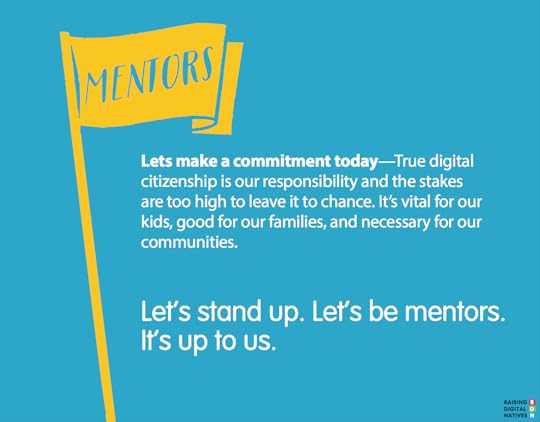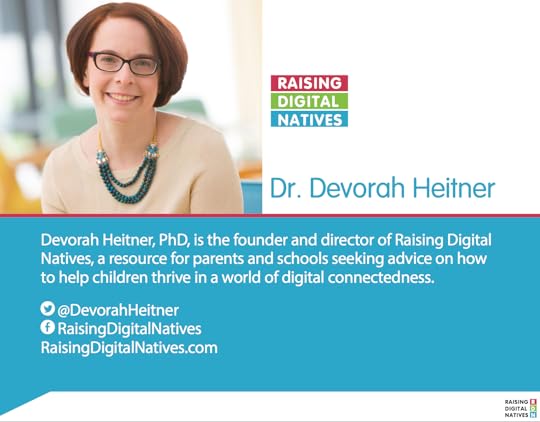Devorah Heitner's Blog, page 7
April 6, 2017
Screentime Battles: When Kids Refuse to Unplug
Many parents who come to my events are excited about my becoming a tech-positive parent…up to a point. But they are also sick of battling with their kids.
Some of them also feel nostalgic for a time where kids would just “go out and play” rather than being immersed in digital experiences.
Often these differences, set against an idealized version of the past, lead to a negative impression of technology in general. This mindset doesn’t help with screentime battles for two reasons:
Technology offers opportunities to our kids in ways that we couldn’t have possibly imagined when we were their age.
Technology will play a crucial role in our kids’ lives, which means that they need to build a set of skills around it.
Think of all the important touchpoints in your child’s life – learning to drive, getting into college, finding their first job, meeting their future spouse. Many of these milestones will be facilitated by technology.
Hiding from these realities is a disservice to your kids’ future. In my field work with parents, my impression is that they understand that – they just don’t know where to begin. Instead of fighting with technology, try re-focusing on becoming a tech-positive parent, with helping kids build a thoughtful relationship with social media, games, etc.
Identify the Concerns
The starting point is fear. If we can name the actual fears, we can address the real concerns. What is it in particular that worries you?
That your child will be detached, not able to interact in the real world.
That your child will be distracted by digital, and never finish anything.
These are understandable concerns, expressed to me by families everywhere.
Refocusing yourself and your family on some of the positive uses of technology will empower you. It will also help you diminish the some of the risks and challenges for your children.
Get Positive About Tech
Positive uses of technology can engage your family with one another, sharing and learning and just plain spending time together. It can help improve their resourcefulness. It can help open up new avenues for learning. It can even help kids better understand how to manage social interactions with peers.
This won’t happen on its own, though. Our kids need us more than ever. This is why we owe it to them to be honest about our concerns get to work mentoring them. As a parent and mentor, it’s up to you to set the tone and create the right environment for your kids – in the offline and online world. One of the best ways that you can do that is to start from the assumption that our children want to do the right thing, they just don’t always know how.
Kids’ intentions are usually pretty easy to understand—they simply want be entertained, to connect with friends, find like-minded peers, and communicate about their identities and feelings. Technology can add layers of complexity to these natural desires and that’s why they need your guidance.
Teaching Good Tech Habits
You set the tone. Your kids will take cues from you. Let’s prioritize technology’s positive aspects when we do so. Here are some simple things you can do:
Try to create a tech-positive environment in your home. Try to foster tech use in a shared space, so that you can “play what your kids play.” Design planned activities, online and offline.
Create fun, attractive, unplugged spaces as well to show that not everything has to be tech-based. Make it OK to get messy. Cook. Jam on instruments. Go outside even when it isn’t “nice.”
Create clearly-defined boundaries and adhere to them. Again, you are modeling for your kids. If you are easily interruptible by a text message from work during unplugged time with your kid, he will get the message that digital communication trumps face to face interaction.
By the same token, modeling respect for privacy and boundaries in the digital world is crucial. Not everyone handles technology in the same fashion. An easy way to start is to ask permission before sharing or posting something about someone. If the person says no, respect that boundary without judgment.
Recognize that the digital world is more complex – it’s changing all the time, with the rules of etiquette still evolving. Both you and your kids are going to make mistakes – and that’s OK. Get comfortable with that notion. The important thing is to find a positive way to offer your kids some guidance, and teach them how to repair, apologize and move forward.
Applying these principles is can help parents like you and me feel more empowered in the face of technology that pervades our kids’ lives. Of course some concern is warranted – there are real dangers. But we always want to be in a position to steer the discussion, be role models, influence habits, and even inspire ourselves and families we know to use the power of technology to make a positive difference in the world!
How Screenwise Are You?
How confident do you feel about your ability to mentor your kids in their digital world? Let’s have a look. I prepared this self-assessment quiz as a good starting point: How Screenwise Are You?
The post Screentime Battles: When Kids Refuse to Unplug appeared first on Raising Digital Natives.
January 31, 2017
How to Talk to Other Parents About Their Child: New Rules for the Digital Age
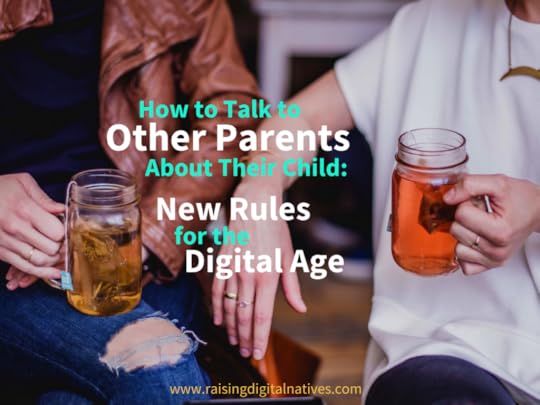 This is the first of a series dedicated to answering questions posed by you. If you have a question about digital citizenship, or about raising your own Digital Native, please send me an email!
This is the first of a series dedicated to answering questions posed by you. If you have a question about digital citizenship, or about raising your own Digital Native, please send me an email!
FROM MY INBOX: These are questions from real parents in my community (though names have been changes to protect their privacy, of course).
Using Instagram Without Permission
Amanda: Reviewing my Instagram feed the other day, I saw a recommendation to follow one of my son’s classmates… she just turned 10. Her mom and I are friends, and I feel a little stuck in what to do next. If I tell her I followed her daughter on Instagram, she may not understand what the implications are. I’m not sure she even understands Instagram or the fact that her daughter should really be 13 to use it (according to the app’s own guidelines). I’m also worried about this harming her relationship with my son. Do I say anything?
My rule is, if I would want to know, then I should say something. In my work with families, I’ve seen how hard it is for parents to talk with other parents about these types of experiences. I realize that there is a lot of judgment and negativity when it comes to our kids’ use of technology, but it doesn’t have to be that way! If we strive for open communication about parenting and technology and take a community-minded approach when we are concerned about children’s behavior, we can all benefit.
I wouldn’t worry about being viewed as an informant. If the mom isn’t aware of what Instagram is then this would be the perfect opportunity for her to learn, and even for you to teach her. Instead of sounding the alarm bells, you can approach the topic lightly instead. Beginning with something like, “wow, I can’t believe our kids are on social media already, they are growing up so fast…” could open the door to a productive conversation.
You could then transition to asking the mom how she felt about you following her daughter or her daughter following you. This way, you aren’t ratting anyone out – the daughter made the first move, anyway.
Social Media Impersonation Accounts
David: My eleven-year-old daughter and I were looking at her e-mail and saw auto-responses from Twitter, Instagram, and several other social applications. I was angry because I thought we had an agreement that she would wait until she was 13 to set up these accounts. Upon further examination, it became clear that the accounts belong to her best friend, a kid I’ve known for years. She just used my daughter’s e-mail account to set them up, as her parents, who are generally stricter than I am, have not allowed her to have e-mail. What should I do?
As I mentioned in my last response, when it comes to digital citizenship, it truly takes a village, and I think that your question is the perfect example of that.
Since you have a relationship with your daughter’s friend, however, you may want to give her the chance to tell her parents directly so that they can have a conversation. If you’re close with her parents, they may also have questions for you about your choice to allow your child to have an email account. If you feel up to it, you can walk them through your approach to mentoring your child (you mentioned you were looking at your daughter’s email with her when you saw these messages), becoming a tech positive parent, and more!
This situation also presents an opportunity to talk to your daughter (and maybe also her friend) about the real-life dangers associated with sharing passwords, and why sharing emails isn’t a good idea. The goal isn’t to scare them, but instead to caution them – point to some real-world examples of times in which this would have been problematic.
Inappropriate Content on the Internet
Ruthie: My 10-year-old son had a friend over, and they were playing on the family tablet. After the friend went home, I noticed some graphic pop-ups left behind from the sites they visited, leaving me to think that they may have used it to view porn. What should I do?
First of all, don’t panic. Try to stay calm at least while you are talking with your child about it. We don’t want to scare them so much that they don’t come to us. These things happen, and is a good lesson to us all that no matter how aware you try to be of what your children are doing on their devices, there can be surprises. That being said, this situation may warrant a conversation about where in the house he is allowed to be on technology (perhaps especially) when his friends are over in the future.
While you aren’t happy to have this chat with your 10-year-old, you may feel particularly unhappy to have to let the other 10-year-old’s parents know this happened. But you would want to know if your kid had seen something like this, so you could help them deal with it. Remember that it is natural for kids to be curious, and they are learning boundaries. The positive thing is that you’ve stepped in to help them—at the right time.
Start by explaining why kids shouldn’t see pornography. “Adults make content for other adults,” and let them know that even many adults feel that such content is not positive, or that it demeans women, or that it depicts a narrow view of sexuality. Pick your own line – you likely have strong feelings about the subject, and it’s perfectly reasonable to let that show.
One woman reported that her nine-year-old searched “sexy naked ladies.” This is a kid who needs good information, to be told his interest is normal and not aberrant. But this is also a kid who – like all kids – does not need to be doing unsupervised Internet searches.
Deborah Roffman, an expert on childhood sexuality, advises that, if your children do see pornography, you talk to them about how different it is from real sex. She also advises that you talk with your kids about the possibility that they will see “naked people” on the computer, once they are old enough to search, and ask them to come and talk to you if they do. Also, be sure they have access to age-appropriate books, films, and other resources about puberty and sexuality.
If the kids are teens, it might make more sense to talk with the other kids directly and to share your concerns about pornography with him instead of his parents. But with elementary or middle school kids, a conversation with parents seems merited.
This is also an indication that your child could use some positive, age-appropriate information about these topics. Check out girlology, guyology, and scarlateen for some guidelines to sex-ed for emerging adults.
Let’s Work Together on Uncomfortable Topics
While learning to mentor and support your own kids is hard enough, it can be scary open up to potentially uncomfortable topics with other parents, at the risk of potential judgment and criticism. This is especially true when the catalyst for conversation feels like something you yourself would be unhappy to hear about.
But these situations come up for all of us, and we as parents need to stick together and look out for one another’s kids in a positive way. You have the power to use these conversations as an opportunity to overcome some of our tech-shaming and taboos around sharing about the challenges of raising kids in the digital age. The more conversations parents have, the more informed we’ll all be, and this can promote a more tech-positive mentality in your community.
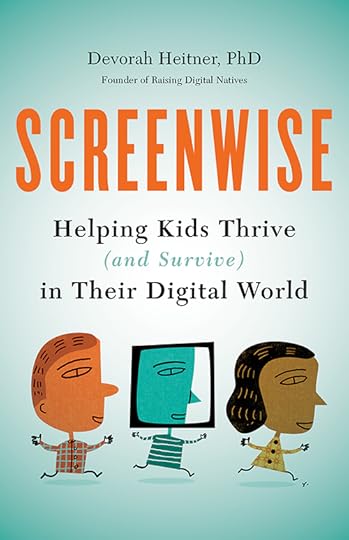 For more stories from parents just like you – and what you can do to become a tech-positive parent, read Chapter 4 of my new book:
For more stories from parents just like you – and what you can do to become a tech-positive parent, read Chapter 4 of my new book:
Screenwise: Helping Kids Thrive (and Survive) in Their Digital World.
The post How to Talk to Other Parents About Their Child: New Rules for the Digital Age appeared first on Raising Digital Natives.
December 5, 2016
Kids Don’t Always Know When News Is Fake
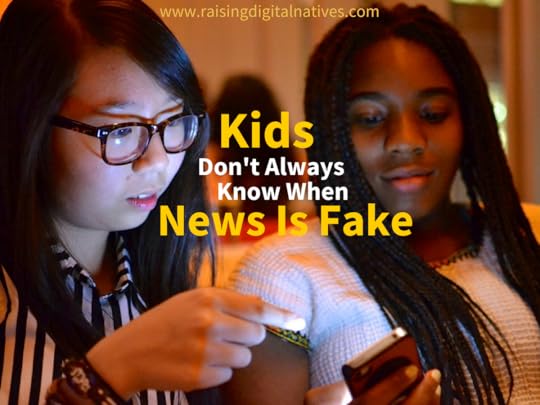 A new study from a group of researchers at Stanford is making waves with the finding that kids can’t identify “fake news” nor can they distinguish “sponsored content” from reported news. Of course, this concerns parents and educators.
A new study from a group of researchers at Stanford is making waves with the finding that kids can’t identify “fake news” nor can they distinguish “sponsored content” from reported news. Of course, this concerns parents and educators.
I spoke to both the Wall Street Journal and the BBC World News about the study, and shared some ideas for how we can mentor kids to empower them be smart consumers of news. Sue Shellenbarger quoted me in the Wall Street Journal article, called Most Students Don’t Know When News Is Fake, Stanford Study Finds.
Helping Kids Be More Media-Savvy
Here are some things you can do to help kids read more critically:
Talk/listen to kids about what they are reading and share what you are reading.
For middle school and high school kids, introduce them to the concept of the “filter bubble.” The “filter bubble” means that our searches and social choices feed algorithms about our preferences that make it more likely we’ll be shown news that confirms, rather than stretches, our view of the world.
For kids of all ages, if they are concerned about what they are hearing or reading, be sure they know they can talk with you about the news.
Advise them to look for terms like “sponsored content” and to turn on their skeptical brain when they read. But we should never make kids feel dumb if they are taken in by a “fake news” story. We want our kids to have healthy skepticism and to be mad at anyone who attempts to dupe them.
Teach kids to check out who produced a story and to consider how different sources might compare in terms of trustworthiness.
What other things have you done to address this issue? Please share them with me in the comments section below, or here on my Facebook page.
The post Kids Don’t Always Know When News Is Fake appeared first on Raising Digital Natives.
October 3, 2016
Digital Citizenship for Kids Starts with Mentorship
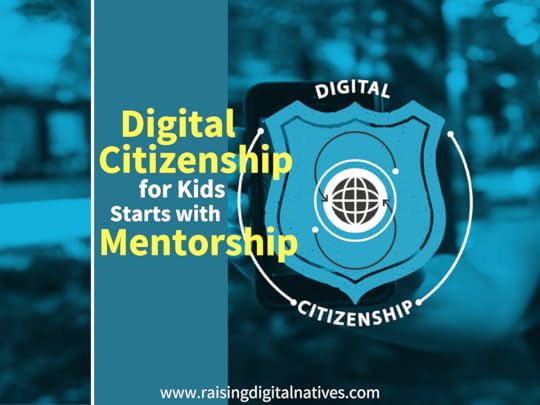 Their world is different from yours. You can feel it, can’t you? You don’t understand the captivating allure of their digital devices. You feel that they are addicted, detached, or distracted. You can’t see what they are doing “on there.” You get suspicious.
Their world is different from yours. You can feel it, can’t you? You don’t understand the captivating allure of their digital devices. You feel that they are addicted, detached, or distracted. You can’t see what they are doing “on there.” You get suspicious.
Sometimes you feel like you understand it though, right? After all, you experience the burden of the new “constant connectivity,” just like anyone else. The never-ending alerts, the new social obligations.
It’s just the tip of the iceberg for today’s Digital Natives. Yes, social pressures are amplified. Yes, digital misunderstandings are rampant. Yes, your kids feel “left out” sometimes. But it goes deeper than that. Deeper than their experiences today. You want to consider how to set your kids up for a lifetime of success in a world where they are likely to meet their spouse, find a job, etc. Like it or not, their world is a Digital World.
Starting Point: Removing Misconceptions
 The First Misconception is that kids think that because they are tech-fluent, they know everything they need to know. Digital citizenship is not about operating the devices. It’s about conducting yourself with empathy and developing meaningful relationships. With your family, with a future spouse, with a future employer.
The First Misconception is that kids think that because they are tech-fluent, they know everything they need to know. Digital citizenship is not about operating the devices. It’s about conducting yourself with empathy and developing meaningful relationships. With your family, with a future spouse, with a future employer.
The Second Misconception is that parents mistake digital proficiency for digital citizenship. Because kids seem “up” on the new technologies and platforms, you consider them fluent. This is dangerous thinking. They need your guidance more than your blind faith.
Why are these misconceptions so important? What’s at stake?
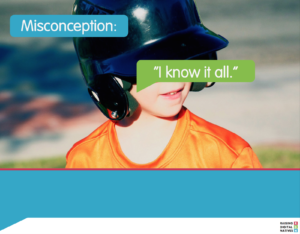 Relationships. As interpersonal relationships are conducted more and more in the digital world, is your Digital Native adept or disadvantaged? These are skills that need to be layered over a foundation of the values you instill in them.
Relationships. As interpersonal relationships are conducted more and more in the digital world, is your Digital Native adept or disadvantaged? These are skills that need to be layered over a foundation of the values you instill in them.Reputation. With every post, every tweet, every share, your Digital Native is creating a persona – while they are experimenting with new identities. It’s a virtual high-wire act. One simple misstep can take years to repair.
Opportunity. The digital world is limitless. Making the right choices about how and where to spend your time is harder than ever. Without mentorship and guidance, rabbit-hole distractions could claim large chunks of precious childhood.
The landscape is different now, and the rules are changing rapidly. Our kids need help, even if they think they don’t. Even if you think they don’t. It’s up to us as parents (and teachers) to ensure that we are helping our kids develop the skills they need to thrive in their Digital World.
The good news? It’s a skill set. And like any skill, it can be learned.
The New Digital Citizenship
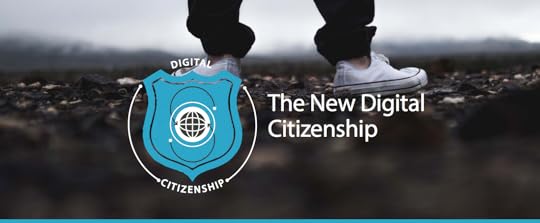 Our kids’ future success will depend on true digital fluency. Their ability to relate to other people and to succeed in their relationships is completely dependent on developing a strong Digital Skill Set:
Our kids’ future success will depend on true digital fluency. Their ability to relate to other people and to succeed in their relationships is completely dependent on developing a strong Digital Skill Set:
This Digital Skill Set is an immediate priority. If they don’t start to develop it now, they won’t succeed in today’s – or tomorrow’s – world.
This Digital Skill Set is not operational or functional. It is not about how to keyboard or how to code. Anyone can learn that part of it, with enough practice.
This Digital Skill Set is about relationships. It’s about what kind of connections we can really have with one another. It’s about trust.
The nuances matter.
The medium matters, and it’s changing all the time. It will continue to evolve. Quickly. How can you keep up? How can you be a good mentor when you feel overwhelmed yourself?
The Solution: Educate Yourself About Kids and Tech
 Simply put, you have to learn in order to teach:
Simply put, you have to learn in order to teach:
Your ability to parent, lead, or teach is affected by your own relationship with technology.
Your relationship with technology is a model for your kids. Learning about their world is a requirement.
You have the capability to relate well to other people. You have the capacity to teach it to others.
You can’t disconnect and say, “I just don’t get this.” Your kids are relying on you to be their guides into this new world.
As parents and mentors, we need to understand and prepare for these new milestones (first email account, first phone, etc.) and prepare our kids.
Conditions are favorable:
Good news. Kids actually want mentorship. They want and need mentorship on relating in the digital age.
Good news. It’s a skill set – it can be learned.
Good news. Kids may be tech-savvy, but you have wisdom. You hold the most powerful piece of the puzzle.
Results are positive:
Parents find that they get closer to their kids and reduce stress in their lives.
Kids elevate their social skills and feel more in control.
Parents feel more “in the know” and not “out of the loop.”
Kids get better at managing repair.
Parents find that trust increases between them and their kids.
Kids feel like their parents are listening to their concerns.
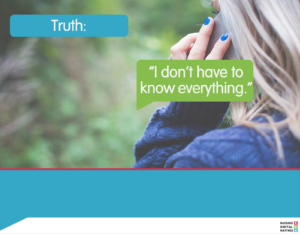 This is good news. Armed with a little knowledge and put into regular practice, you can make a positive difference in the lives of your Digital Natives.
This is good news. Armed with a little knowledge and put into regular practice, you can make a positive difference in the lives of your Digital Natives.
Let’s take the pressure off, though. You don’t have to know everything. And you don’t have to learn it all at once. But you do need to be in the conversation. If you’re not a part of their world, you can’t influence their world. The key that unlocks it? Trust.
Developing trust starts with Empathy.
You have to make the first move. Empathy is the first step towards trust.
It requires patience and persistence. Just like anything else in parenting!
It requires balance. The kids are alright! Not everything is cause for concern.
Empathy is the fuel of Mentorship.
Monitoring in the Digital Age is an illusion of control.
In the digital age, we need to be Mentors, not Monitors.
Mentorship is the single most important commitment we can make to our kids. It doesn’t matter whether we are parents, teachers, school leaders, or administrators. If we interact with kids regularly, we are part of a community where mentorship is our responsibility.
Raising Digital Natives: It’s Up to Us
We need to solve these problems together, or we run the risk of a new generation that doesn’t take full advantage of the possibilities before us. Burying our heads in the sand or trying to limit our kids’ “screentime” is not going to take us to the next level.
Let’s make a commitment today – to our kids and to one another.
Let’s stand up. Let’s be mentors. It’s up to us.
The post Digital Citizenship for Kids Starts with Mentorship appeared first on Raising Digital Natives.
September 14, 2016
The Mentorship Manifesto
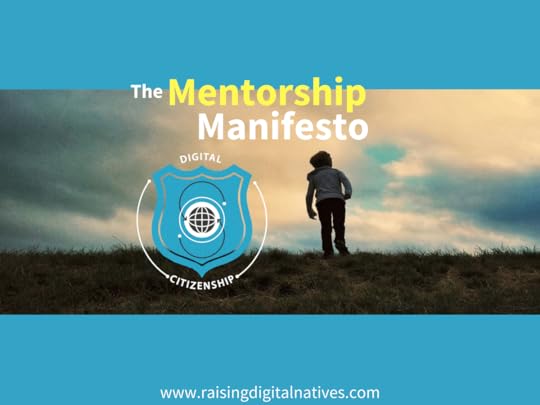 Mentorship is the single most important commitment we can make to our kids. It doesn’t matter whether we are parents, teachers, school leaders, or administrators. If we interact with kids regularly, we are part of a community where mentorship is our responsibility.
Mentorship is the single most important commitment we can make to our kids. It doesn’t matter whether we are parents, teachers, school leaders, or administrators. If we interact with kids regularly, we are part of a community where mentorship is our responsibility.
I created this “Mentorship Manifesto” as a declaration of that responsibility.
Who Are We as Mentors?
We are optimists. We don’t make assumptions about what kids do with technology. We give them a chance and we stick to the facts. We don’t succumb to fear.
We are tech-positive. But though we believe that technology can be a positive force, we don’t think that technology is all-powerful.
We believe in curiosity. Technology is a means to learn—to do other things. Kids’ minds are alive. If used properly, technology unlocks kids’ natural creativity.
We get excited about kids and their creativity. We believe that we can learn from kids as much as they can learn from us.
We recognize that misunderstandings happen all the time between adults and kids. We commit to getting better at identifying and addressing these gaps in understanding.
We believe that kids are fascinating, and that we need study them in their habitat to truly understand them. We want to be invited into their world.
What Do We Believe as Mentors?
We as mentors start from a place of empathy as a path to trust and open communication.
We as mentors see that kids are very creative and insightful—but that they still need modeling and they still need help navigating this world.
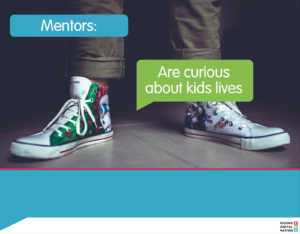 We as mentors recognize that being tech savvy is not the same as wisdom. Our life experience is a critical factor in the equation.
We as mentors recognize that being tech savvy is not the same as wisdom. Our life experience is a critical factor in the equation.We as mentors believe in collaboration over control. Co-creating solutions with kids takes advantage of their creativity and builds trust at the same time.
We as mentors recognize the need to observe kids in their habitat in order to get a better understanding of their lived experiences.
We as mentors recognize that the realm of social interactions is more complex now, and that kids need help in order to build good personal relationships.
We as mentors believe in the power of curiosity to activate young minds.
We as mentors don’t want to catch their kids doing the wrong thing – we want to teach our kids to do the right thing!
We as mentors believe in creativity over consumption. All screentime is not created equal.
We as mentors understand that tech limits alone are no substitute for engagement. Monitoring degrades trust in exchange for a false sense of control.
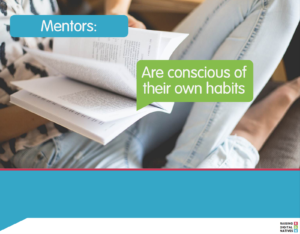 We as mentors understand that part of growing up is about experimenting with identities, and that issues around “digital footprint” can constrain kids in the wrong way at the wrong time.
We as mentors understand that part of growing up is about experimenting with identities, and that issues around “digital footprint” can constrain kids in the wrong way at the wrong time.We as mentors are ready to be accountable to kids, in turn. The good and bad habits we harbor with technology serve as a model for kids.
We as mentors provide room for learning and self-discovery, making plans that don’t come from our anxiety and desire for control.
We as mentors lead their families, teams, and community in service of a positive digital world for the next generation.
Raising Digital Natives: A Commitment
Join me in making a commitment to these principles today – a commitment to our kids and to one another. The way we interact and communicate will keep changing, but one thing remains the same: True digital citizenship is our shared responsibility and the stakes are too high to leave it to chance. It’s vital for our kids, good for our families, and necessary for our communities.
Let’s stand up. Let’s be mentors. It’s up to us.
About Devorah Heitner and Raising Digital Natives
The post The Mentorship Manifesto appeared first on Raising Digital Natives.
August 29, 2016
Mayim Bialik and Her Decision NOT to Let Her Kids Have Smartphones
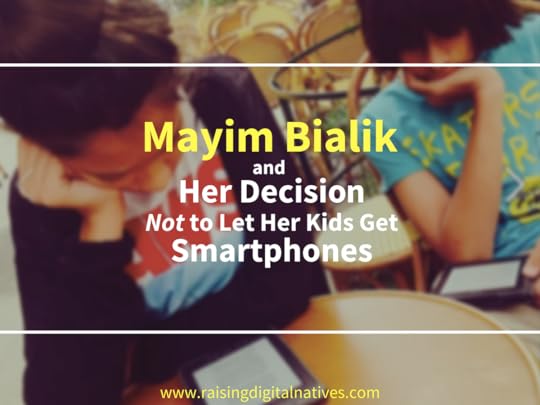 Like a lot of people my age, I grew up watching Mayim Bialik on Blossom. You might be more familiar with her from her award-winning role on The Big Bang Theory. I love that her character portrayals are smart and confident, yet self-conscious and nerdy at the same time.
Like a lot of people my age, I grew up watching Mayim Bialik on Blossom. You might be more familiar with her from her award-winning role on The Big Bang Theory. I love that her character portrayals are smart and confident, yet self-conscious and nerdy at the same time.
In between the two TV shows, she studied to become a neuroscientist at UCLA, earning her PhD in 2007. I admire her for this. Even though she already had a career as an accomplished and successful actor, she still took on another challenge in another very competitive field.
Today, in addition to her career, Bialik started publishing her perspective on both acting and parenting (she’s the mother of two young children). I’ve been impressed by her honesty about the pleasures and challenges of raising kids today’s world. Bialik is smart, outspoken, and complex. Her website, Grok Nation, brings together interesting ideas and snappy writing. Though I’ve always been a fan of hers, never more so than today. She’s a great role model, from young girls growing up to professional women.
So, you can imagine my delight and surprise when I heard she had read my new book, Screenwise: Helping Kids Thrive and Survive in Their Digital World. She wrote a really lovely and thoughtful reflection about it on Kveller, a parenting website. She talked about why she’s not getting her kids smartphones, and about re-examining her own tech habits. You can read the whole article here.
The post Mayim Bialik and Her Decision NOT to Let Her Kids Have Smartphones appeared first on Raising Digital Natives.
August 2, 2016
Pokemon Go: The End of Civilization or a Family Opportunity?
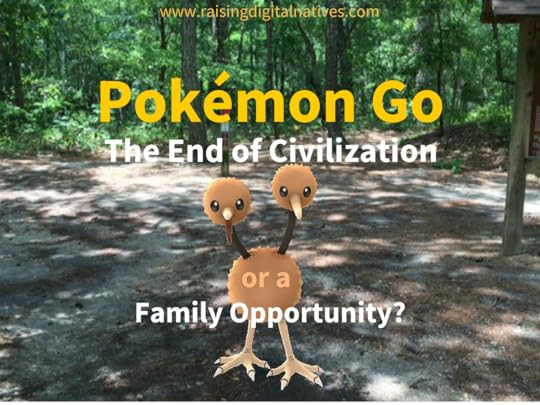 Family life is stressful is today’s world. My family is just the three of us and our cat. Our busy kid is somehow doing sports, martial arts and piano…though I always said I wouldn’t over-schedule! Work is busy preparing for my book launch! We moved this summer and spent our “vacation fund” on the move. We are looking for that “summer feeling,” but have made it to the beautiful Lake Michigan beaches a mile from our new place exactly once.
Family life is stressful is today’s world. My family is just the three of us and our cat. Our busy kid is somehow doing sports, martial arts and piano…though I always said I wouldn’t over-schedule! Work is busy preparing for my book launch! We moved this summer and spent our “vacation fund” on the move. We are looking for that “summer feeling,” but have made it to the beautiful Lake Michigan beaches a mile from our new place exactly once.
I’m sure you can relate. Other families I know seem stretched, too. My mother-in-law tells stories about spending entire summers on lakeside beaches with moms and kids (and maybe even nannies?!) while “the fathers” went to work during the week. What?! This world (and division of labor) sounds completely foreign to me. What would that kind of life even feel like? When you think of what your world is like today, you’d probably agree that it’s quite difficult to imagine.
Technology Makes Things… Better?
A lot of parents I know blame technology for the pace of today’s world, and that’s understandable. When our son listlessly opens 30 apps in ten minutes, binge-watches 3-4 episodes of a show, or generally goes into “screen monster” mode, I feel a flash of reflexive guilt. I know I am not alone in this feeling. I take all the credit when my role as a “technology mentor” opens the door to family fun and harmony, but I am quick to blame the technology when things don’t go so well.
But for all the challenges, I try to look at technology in a different way. When technology brings us together—a favorite family movie, the shared enjoyment of trash-talking while my son plays his favorite baseball app with his dad, or our whole family cracking up at Siri’s hilarious responses to our iPhone queries, it makes us all feel good. And sure—I’ll take all the credit! But some of these things wouldn’t be possible without technology.
But What About Pokémon Go?
The conversation around Pokémon Go intrigues me. If you haven’t heard about Pokémon Go, it’s a game that feels more like a craze at the moment. Kids (and adults too!) use their mobile phones to track and “capture” cartoon characters to compete for points and rankings. What makes this a very different phenomenon from other game “crazes” is that 1) it’s a virtual layer over the “real” world, and 2) you can only succeed if you get out and walk to each of the game’s many locations.
Parents are saying that playing together with their kids is a positive experience because it gets kids outside, but they are also bemoaning the idea that the app “makes” you go outside. And of course, there are a lot of dangers “out there” from predators to busy streets and highways. It doesn’t help that game players are walking around staring down at their smartphones.
Though parents like the social aspect of bringing the family—or groups of kids—together, they still worry that these groupings may be “Alone Together,” a phrase technology researcher Sherry Turkle helpfully offers to describe these moments. We’ve all seen two people out on a date at a restaurant, sitting across from one another, but each staring at their phones. When we are spending time together, yet disconnected because we are so involved with what’s happening “out there” in the digital world.
Pokémon Go… or Pokémon Stop?
So let’s play some Pokémon Go! It’s my job to stay up on digital trends, so we’ll call it research, right? I can tell you, that so far, we’ve had an amazing time with our kid out in the neighborhood meeting some Pokés, and some real wildlife, too! On our last excursion, we discovered a new pie shop in the neighborhood too!
When we have positive experiences like this, we feel great. We are winning techno-parenting! One family with a kid on the Autism Spectrum found that interacting with Pokémon Go (and other young players)n unlocked new social opportunities and flexibility for their child.
But when a kid wanders onto a highway or simply has a Poké-related meltdown it can feel like we are “losing” techno-parenting. One mom went from super enthusiast to frustrated realist when her kids started fighting, demanding to be driven all over town and throwing tantrums about the game. The funny thing (and we all do it) is when we feel like technology is supporting our parenting, we take the credit. I am a fabulous parent and I’ve brought my kid the best, most educational apps and look at my family flourish. But when things aren’t great, we want to blame the technology. “If only the school hadn’t sent home those iPads, my kid would be getting his homework done.” “If only I couldn’t check my email on vacation, I’d be a more connected parent.”
A little perspective is in order though. As a rule, technology doesn’t determine our moods, interactions, and relationships as much as we may think it does. As Alexandra Samuel points out, parents should resist “techno-shame.” Even though sometimes other parents act smug about their brilliant approach to screentime, and other parents act ashamed of their kids’ technological engagements, there is truly no “winning” and “losing.” We all just have to find what works for our own families.
I’m not sure if we’ll stick with Pokémon Go. Like any other immersive game, I try to have a strategy for my kid. I don’t want to foster the “screen monster” in him, and I certainly don’t want it to be the cause of public meltdowns. So we’ll take it with step by step, and co-create solutions to what isn’t working. For you, that might mean not starting at all. Don’t feel pressured to jump on the next trend. There is no perfect approach to raising digital natives; just do what fits your family.
Judgments are not helpful. You are not winning or losing parenting in the digital age. You are living with it, and so are your kids.
Devorah Heitner is the author of Screenwise: Helping Kids Thrive (and Survive) in Their Digital World and the founder of Raising Digital Natives.
—
Photo credit: “FL-Trail Center” by Virginia State Parks is licensed under CC BY 2.0. Changed from original: Added text overlays.
The post Pokemon Go: The End of Civilization or a Family Opportunity? appeared first on Raising Digital Natives.
May 3, 2016
Minecraft Resource Roundup for Parents
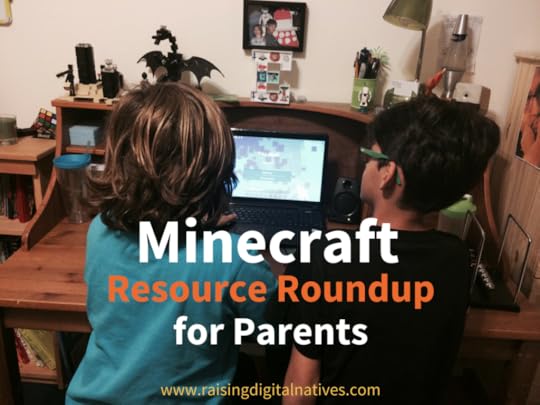 Kids love Minecraft. Many adults too! But lots of parents tell me they don’t understand their child’s relationship with Minecraft. Or that their kids don’t want to sleep, eat, or do their homework because they are playing Minecraft (or other games, for that matter). Or that they have gaming “rage” from conflicts with friends or siblings—fighting about the game, or inside the gaming environment itself. Or that they want to spend all their time watching other players play the game on YouTube—many parents find this to be the most confusing behavior of all.
Kids love Minecraft. Many adults too! But lots of parents tell me they don’t understand their child’s relationship with Minecraft. Or that their kids don’t want to sleep, eat, or do their homework because they are playing Minecraft (or other games, for that matter). Or that they have gaming “rage” from conflicts with friends or siblings—fighting about the game, or inside the gaming environment itself. Or that they want to spend all their time watching other players play the game on YouTube—many parents find this to be the most confusing behavior of all.
What’s So Great About Minecraft?
I recently interviewed two young gamers about Minecraft. Their names are Jonathan and Elliot, and they explained what they love about it. Their extensive familiarity with the options and different modes of play were impressive. The appeal of a game where you have so much control over designing the “world” you are playing in makes sense to me.
“You go to options and you create a new world.”
Think about the life of your child and how much control they have over their day-to-day world. Sometimes it feels like we run them from activity to activity, and you can understand how appealing it might be to them to actually create, navigate, and manage their own world.
This instinct is perfectly natural. Minecraft seems to understand this, and offers a variety of fun and different challenges. For example, you can play in “survival mode,” “creative mode,” and “adventure mode.”
You can play alone or with friends. As the Minecraft site explains, it’s “a place where everyone can play together, no matter how far away they live in real-life. Somewhere to cooperate, compete, and adventure.” As Elliot explains about his gaming friends:
“Sometimes I am playing and I don’t even know that
[my friends] are online [playing the game too].
I’ll see that they want to talk.”
Gamers can also create “Minecraft Realms,” where up to 10 people can play on at once (though up to 200 people can be given access). Jonathan gushes about this feature:
“You can choose what type of world you want. Amplified features, huge mountains, large biomes in a jungle.”
Both single-player and multiplayer modes are fun, according to Jonathan and Elliot. What strikes me the most is the boys’ pride in their accumulated knowledge and skill as well as their camaraderie in playing together.
Mediating Minecraft—and Other Games
How can you integrate your kids’ gaming obsession into the rest of family life? Sure, the game is creative—but sleep is also good for creativity! Even if you feel that it’s a good creative outlet for your kids, there still have to be boundaries.
My interview subjects—and more importantly, their parents—feel that gaming integrates pretty well into the mix of friendship, homework, family life, and sleep—with some important caveats! Jonathan’s mother clarifies that his access to gaming time is dependent on having finished homework and keeping up with his responsibilities at home such as keeping his room clean.
Jonathan’s and Elliot’s mothers both say they feel positive about their sons’ gaming for the most part, and that when they do feel like it is “too much” or “interfering” with other activities, the parents work with the boys to balance it with other activities.
Balance is a good approach—and a signal too. In my experience working with parents, there are simple signs that gaming has become a problem. For instance, when limits that you set are met with extreme reactions, this is a signal that a new approach to gaming may be necessary.
My recommendation: Get involved. Know what you’re kids are playing and with whom they are playing, too. As I advise in my new book, Screenwise: Helping Kids Thrive and Survive in Their Digital World, you want to familiarize yourself with their favorite games—and even celebrate their successes!
Minecraft Resources for Parents
Here is a resource roundup of great sources for more Minecraft learning.
Clean Minecraft Videos is especially useful for younger Minecrafters who enjoy watching Minecraft videos on YouTube. This is a curated resource of over 200 videos that are appropriate for all ages. I met the creators of this website at ICE Illinois, an educational technology conference and I was so impressed with their initiative. The creators are students themselves, and they saw a need. Because the Minecraft videos you might find on YouTube are sometimes filled with language you’d prefer not to share with your second grader, they provided a fun, alternative source.
Alexandra Samuel’s “Family Minecraft Policy” will be helpful for many families trying to find the balance of how Minecraft fits into family life, school, and your day-to-day routine. Dr. Samuel is one of my favorite researchers on how we live with, learn with, and work with technology.
This quick slideshow offers 5 Reasons to Get More Girls Playing Minecraft. It was created by Leah Rocketto on Pop Sugar. Reasons include: It introduces them to new careers and it offers a level playing field, with boys and girls, in a gaming environment.
The Minecraft Generation is an article by Clive Thompson, which appeared in a recent issue of the New York Times. This is a very thoughtful analysis of how the game is nurturing a generation of players to be experimental in the digital world in ways that lead to deep learning.
My advice, as always, is play what your kids play. There’s no better way to learn about their world than to try to see it through their eyes. You don’t have to become a Minecraft master—just experience it enough to understand and appreciate their skills and experience.
Devorah Heitner is the author of Screenwise: Helping Kids Thrive (and Survive) in Their Digital World and the founder of Raising Digital Natives.
The post Minecraft Resource Roundup for Parents appeared first on Raising Digital Natives.
March 16, 2016
Conflict Resolution for Digital Natives
 Conflict resolution is always difficult. Think about the last time you had a significant disagreement with a friend, neighbor, co-worker, or even your spouse. These situations are emotionally fraught, and it can often feel like neither side wins, even after the conflict has been resolved.
Conflict resolution is always difficult. Think about the last time you had a significant disagreement with a friend, neighbor, co-worker, or even your spouse. These situations are emotionally fraught, and it can often feel like neither side wins, even after the conflict has been resolved.
Kids deal with small conflicts every day—it’s part of growing up. But their conflicts now have a different dimension, and are often made more complicated by technology. While today’s devices allow us to be connected in ways we couldn’t even imagine when we were kids, technology has added layers of complexity to the social sphere.
If you are a regular reader, you know me to be very tech-positive. I believe that the benefits outweigh the hazards—if and only if we develop the necessary skill sets to use the technology the right way.
That’s good news. If we treat it like a skill set, that means it can be learned—and more importantly, taught. The challenge is that there’s a pretty wide continuum of unkind and difficult behaviors, ranging from perceived slights to thoughtlessness, unkindness to intentional drama and gossip, and in extreme cases, bullying.
A further challenge is that the rules, conventions, and expectations are still evolving. While it seems like text messaging has been around “forever,” it’s still new enough that everyday behavior is not yet governed by a clear set of cultural norms. It’s still very much in flux, which makes parents feel like they are “behind the times,” and “can’t keep up” with what their kids know.
More good news—if you feel equipped to help your kids handle a face-to-face conflict, then you are just as equipped to help them handle online issues as well. Like I said, it’s a skill set.
The Screen Connects, but the Screen Distorts
There is the tendency to feel less empathetic when there’s a screen in between. Also, difficult emotions can be tempered, twisted, or misconstrued when filtered through the screen. Sometimes we say things online that we would not say in person.
Choosing a communication medium wisely—and not out of fear—is part of the skill set of conflict resolution. We as parents and mentors need to talk explicitly with kids about how to decide when digital communications are appropriate, and when to talk in person.
You may see this in your own workplace, where an e-mail miscommunication leads to a chain of conflict. What do you do? Walk down the hall or pick up the phone! The appropriate medium makes a huge difference, and you can teach the same skills to your kids.
Unintentional Harm: Gossip
Gossip has been around since humans could communicate. However, technology can be an accelerant, enabling it to spread more quickly via social media, text messaging, or group chat.
Also, what happens when we are “recruited” into other people’s conflicts? What if a nasty exchange erupts as part of a group text, or someone posts a rude comment on someone else’s Facebook post? Do you get involved? Will that help—or make it worse? As I say frequently, conflict can be a spectator sport.
Sometimes we find that we avoid conflict ourselves, but are more than willing to get involved in other people’s conflicts instead. Teaching kids restraint is a good practice here—or to seek advice from an adult. These issues are complicated. There’s no shame in asking for help!
Intentional Harm: Bullying
Like gossip, bullying has been around forever, too. What’s different now then? Social media, texting, and hand-held devices provide kids with more tools to cause harm to one another.
It is incredibly easy to intentionally stir up drama between others by sharing something that you know might be upsetting. Or posting in ways that are intentionally vague and “coded” so that they will not be understood by everyone—but definitely understood by the person being attacked.
It’s important for parents and teachers to detect the nuanced differences between minor, everyday conflicts (which are very normal) and things that have escalated to intentional harm. Knowing where that line is allows you to be proactive in helping the child manage the situation. Resolving “true” bullying almost always requires the help of an adult.
No Reaction is a Good Reaction
There is a big difference between reacting and responding. Conflict usually requires a response, but a reaction can make it worse before it gets better. Think about that e-mail exchange—the back and forth chain of reactions is almost always negative!
When we can, we should practice mindfulness and NON-REACTIVITY. Take a breath. Research shows that we actually hold our breath when checking email. We want oxygen in our brain.
Kids complicate this further. They commonly show their text messages to their friends (maybe to “recruit” others to their side), so many people may be evaluating a piece of communication. This usually doesn’t go well. Between two young people in middle school, any question can sound accusatory, and any answer can sound curt. It is very easy to commit an offense.
Put Down the Devices and Talk Face to Face
When all else fails, attempt to meet in person. Maybe with parents or teachers present, or maybe just kid to kid. We have to let kids know that when they get a message via Instagram, Snapchat, or Messenger that upsets them—stop and take a breath. Count to 10. Whatever creates space. Then, if possible, let’s try to talk face-to-face or at least by phone. Try not to let minor issues become major problems.
Kids communication centers around their devices. So it’s natural for technology to be their “go-to” in conflict resolution. After all, it’s how they communicate. But it is especially important for kids to understand that it is extremely difficult to repair an emotionally-charged situation without communicating in person.
Think of times where you were able to diffuse a disagreement in one face-to-face conversation—or even just a sympathetic look and the question, “do you want to talk?” You know how to do this, and you know how to teach your kids this. Devices don’t change the fact that it’s still just human communication.
Helping Kids with Conflict Resolution
Though devices complicate the social sphere, you can see that at base, the issues are the the same as they’ve always been. This is why I repeat the mantra over and over again: Mentoring Over Monitoring. My book, Screenwise: Helping Kids Thrive (and Survive) in Their Digital World helps parents to be better mentors. Trying to control the technology is a fool’s errand—it changes too quickly, and your kids will always be ahead of the curve anyway. However, good, strong mentorship is the best way to help them learn how to manage their relationships—online and offline.
Devorah Heitner is the Author of Screenwise: Helping Kids Thrive (and Survive) in Their Digital World and the founder of Raising Digital Natives.
—
Photo credit: “day 016” by Holly Lay is licensed under CC BY 2.0. Unchanged from original.
The post Conflict Resolution for Digital Natives appeared first on Raising Digital Natives.
February 13, 2016
Tweens and Teens Dating in the Digital Age
Romance , Love, and Crushes in the Digital Age
Pew Center for Internet and American Life is one of my favorite sources of useful data on how kids and families are using technology. In October 2015, they released a study showing that, (surprise!) kids are still falling in love, getting crushes, getting mad, getting even, etc.
So things haven’t changed…that much. But for those parents who worry about the new added complications of technology on dating life, I have some good news: at least in 2015, most kids were not actually meeting or “hooking up” with other people online.
It may feel like dating has moved entirely to the Internet, but according to the Pew study, only 8% of all American teens have met a romantic partner online. Though we see a few young people are using Tinder, Grindr and other “hookup” apps, these are supposed to be only used by those eighteen or older. Also, as one mother of a 9th grader told me, despite the racy implications, her son started a “traditional” dating relationship with a girl he met via Tinder. In this day and age, “traditional” meant that she drove her son to a bookstore café to meet the girl in person for the first time while she waited outside. Since then, this particular mom has met the girl’s parents, and have gotten together to go out to the kids’ basketball games and to one another’s school plays. While the kids live 20 minutes apart in different suburbs–and might not have otherwise met–their relationship itself does not seem different to his mother than if they had met at a swim meet or debate tournament.
Connection, Connection, Connection
Once teens or tweens are involved romantically, their expectations are surely affected by the availability of constant connection. This is directly in parallel with the changes in expectations in our own adult relationships. For example, my husband and I were dating before we had cell phones, and our expectations for being in contact (while far lower than these teenagers!), are still more frequent than they were before we had these devices with us at all times. Fully 85% of young people surveyed, expected to hear from their partner at least once a day. 11% expected to hear from their partners once an hour!
Teens are just getting used to all the physical and emotional changes that come with puberty and one of those is the infatuation with others their age. While in the past, flirtatious exchanges were confined to lunch and the occasional movie, today every couple can keep in never-ending contact via the phone in their pocket. When talking to your child, remind her that even though she can reach out to her crush at all times does not mean she has to. It’s okay not to text.
On the other hand, flirting, dropping hints, and trying to figure out how mutual an interest or crush is (age old preoccupations) has moved more into the digital realm. In the PEW study, 50% of teens reported that they used Facebook or other social media platforms to flirt or express romantic intentions. While they still may prefer to meet at school or through friends, social media is often times where they feel comfortable discussing their feelings.
Breaking up is Still No Fun
On the other end of the “feelings” spectrum, kids are negotiating both breaking up relationships and fending off unwanted attention in both the traditional ways (face-to-face, phone) and the digital realm (social media, texting, email). The PEW study reports that 25% of all teens have unfriended or blocked someone on social media because that person was flirting in a way that made them uncomfortable Perhaps, not surprisingly, Teen girls are more likely to receive uncomfortable flirting online with 35% reporting they’ve had to unfriend or block someone, more than twice as many as the 16% of boys who have had to do the same.
Talk to your kid
Ask your kid how other kids in their school and community ask other people “out” or to become involved. What are the local customs? If your are concerned about harassment, one way to open the door to conversations about these kinds of experiences is to ask your child if she or her friends has ever had to block someone for coming on too strong–or being too persistent. Make sure she knows that this behavior is unacceptable and that she doesn’t have to put up with it. If the behavior doesn’t stop by un-friending or blocking the perpetrator, contacting the school–or the authorities–may be necessary.
Most of what we know about dating for young people in the digital age should remind us to have empathy for kids…learning to deal with romantic feelings towards other is as awkward, terrifying and exhilarating as it ever was!
For Reference
“Teens, Technology and Romantic Relationships.” Pew Research Center Internet Science Tech RSS. 01 Oct. 2015. Web. 31 Jan. 2016.
..
The post Tweens and Teens Dating in the Digital Age appeared first on Raising Digital Natives.

